Best fertilizers for a vegetable garden are crucial for cultivating healthy, thriving plants that yield abundant harvests. Whether you’re a seasoned gardener or just starting out, understanding how to nourish your soil is essential for success. This guide delves into the world of fertilizers, exploring different types, application techniques, and sustainable practices to help you choose the best options for your vegetable garden.
We’ll start by examining the importance of soil testing to identify nutrient deficiencies, followed by a comprehensive overview of essential nutrients for vegetable growth. Next, we’ll dive into the world of fertilizers, comparing organic and synthetic options, and providing detailed information on their benefits and drawbacks.
We’ll also discuss the best fertilizers for specific vegetable types, ensuring your plants receive the optimal nutrition for their unique needs. Finally, we’ll explore sustainable fertilizing practices that promote soil health and minimize environmental impact.
Understanding Soil Needs
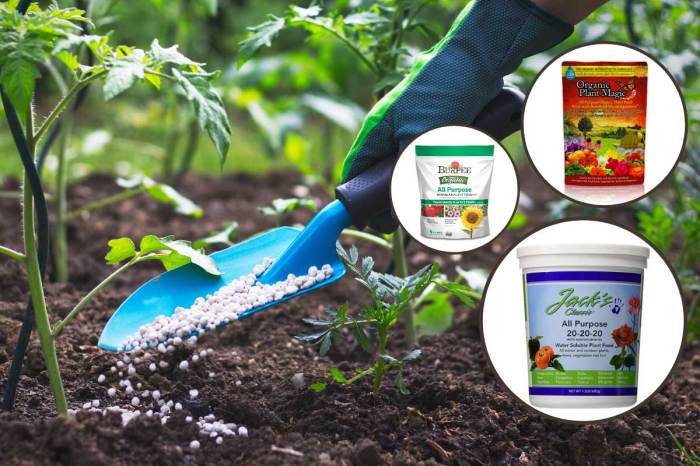
Before you start fertilizing your vegetable garden, it’s crucial to understand the needs of your soil. Just like people, plants have specific nutritional requirements for optimal growth. Soil testing can help you determine the nutrient deficiencies in your garden, allowing you to tailor your fertilizer application for maximum effectiveness.
Soil Testing
Soil testing is a valuable tool for understanding the chemical composition of your soil. It helps determine the levels of essential nutrients, pH, and other important factors that influence plant growth. You can send soil samples to a certified lab for analysis, or use home soil testing kits available at garden centers.
Essential Nutrients for Vegetable Growth
Vegetables require a variety of essential nutrients for healthy growth and development. These nutrients can be broadly categorized into macronutrients and micronutrients:
Macronutrients
Macronutrients are needed in larger quantities by plants. They play vital roles in various plant functions:
- Nitrogen (N):Essential for leaf growth, chlorophyll production, and overall plant vigor. Nitrogen deficiency can result in stunted growth, yellowing leaves, and reduced yield.
- Phosphorus (P):Crucial for root development, flower formation, and seed production. Phosphorus deficiency can lead to poor root growth, delayed flowering, and purplish leaves.
- Potassium (K):Important for disease resistance, water regulation, and overall plant health. Potassium deficiency can cause wilting, weak stems, and brown leaf margins.
- Calcium (Ca):Necessary for cell wall formation, root growth, and fruit development. Calcium deficiency can lead to blossom-end rot in fruits and stunted growth.
- Magnesium (Mg):Essential for chlorophyll production and photosynthesis. Magnesium deficiency can result in yellowing between leaf veins (chlorosis).
- Sulfur (S):Plays a role in protein synthesis and chlorophyll production. Sulfur deficiency can cause stunted growth and yellowing leaves.
Micronutrients
Micronutrients are required in smaller quantities but are equally important for plant health. They act as catalysts in various biochemical processes:
- Iron (Fe):Essential for chlorophyll production and photosynthesis. Iron deficiency can cause yellowing of young leaves (chlorosis).
- Manganese (Mn):Involved in photosynthesis and nutrient uptake. Manganese deficiency can lead to stunted growth and brown spots on leaves.
- Zinc (Zn):Important for growth regulation and enzyme activity. Zinc deficiency can result in stunted growth and deformed leaves.
- Copper (Cu):Necessary for photosynthesis and enzyme activity. Copper deficiency can cause stunted growth and wilting.
- Boron (B):Essential for cell wall formation and pollen development. Boron deficiency can lead to stunted growth, blossom-end rot, and deformed fruits.
- Molybdenum (Mo):Involved in nitrogen fixation and enzyme activity. Molybdenum deficiency can cause stunted growth and yellowing leaves.
Types of Soil
Soil types vary in their texture, structure, and nutrient-holding capacity, which can significantly impact plant growth. Here are some common soil types:
Sandy Soil
Sandy soils have large particles, resulting in excellent drainage but poor water retention. They tend to be low in nutrients and can be prone to nutrient leaching.
Clay Soil
Clay soils have small particles, leading to poor drainage and compaction. They can hold nutrients well but can be difficult to work with.
Loam Soil
Loam soils are a mixture of sand, silt, and clay, offering a good balance of drainage, water retention, and nutrient holding capacity. They are generally considered ideal for vegetable gardening.
Types of Fertilizers
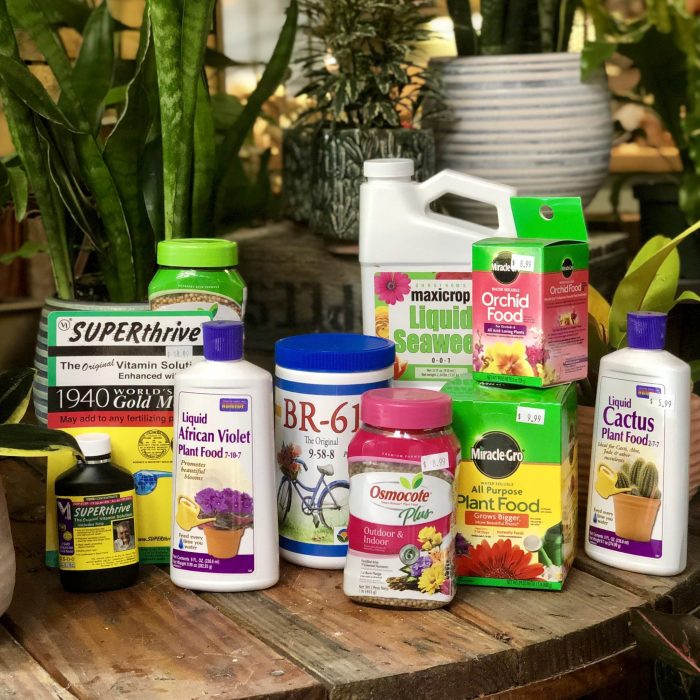
Choosing the right fertilizer for your vegetable garden is crucial for healthy growth and bountiful harvests. Understanding the different types of fertilizers available and their specific benefits and drawbacks will help you make informed decisions for your garden.
Organic vs. Synthetic Fertilizers
Organic and synthetic fertilizers represent two distinct approaches to providing nutrients to plants. Both have their advantages and disadvantages, and the best choice depends on your gardening philosophy, budget, and environmental concerns.
| Fertilizer Type | Key Nutrients | Application Methods | Advantages/Disadvantages |
|---|---|---|---|
| Organic | Nitrogen (N), Phosphorus (P), Potassium (K), and other micronutrients | Compost, manure, fish emulsion, bone meal, blood meal, etc. |
|
| Synthetic | Nitrogen (N), Phosphorus (P), Potassium (K), and sometimes micronutrients | Granular, liquid, and slow-release formulas |
|
Common Types of Organic Fertilizers
Organic fertilizers are derived from natural sources and offer a range of benefits for your garden.
- Compost: A decomposed mixture of organic materials like leaves, grass clippings, and food scraps. It’s a versatile and readily available fertilizer that improves soil structure, water retention, and nutrient content.
- Manure: Animal waste that provides a rich source of nutrients and organic matter. Different types of manure, like cow, horse, or chicken manure, have varying nutrient compositions and should be used with caution due to potential for pathogens.
- Fish Emulsion: A liquid fertilizer derived from fish parts. It’s rich in nitrogen, phosphorus, and potassium, and also contains beneficial amino acids and enzymes that enhance plant growth.
- Bone Meal: A powdered fertilizer made from ground animal bones. It’s a good source of phosphorus and calcium, essential for strong root growth and flower production.
- Blood Meal: A dried and ground blood product that is a high-nitrogen fertilizer. It provides a quick boost of nitrogen for leafy green vegetables.
Common Types of Synthetic Fertilizers
Synthetic fertilizers are manufactured from chemical compounds and provide a concentrated source of nutrients. They are often classified based on their form and nutrient content.
- NPK Fertilizers: These fertilizers are named after the three primary nutrients they contain: Nitrogen (N), Phosphorus (P), and Potassium (K). The numbers on the fertilizer label indicate the percentage of each nutrient. For example, a 10-10-10 fertilizer contains 10% nitrogen, 10% phosphorus, and 10% potassium.
- Granular Fertilizers: These are solid, granular fertilizers that are easily applied to the soil. They are available in various nutrient ratios and are typically slow-releasing, providing a steady supply of nutrients over time.
- Liquid Fertilizers: These are readily absorbed by plants and are often used for foliar feeding or as a soil drench. Liquid fertilizers can be easily mixed with water and applied to the garden.
- Slow-Release Fertilizers: These fertilizers release nutrients gradually over time, reducing the risk of nutrient burn and leaching. They are often coated with a protective layer that dissolves slowly in the soil.
Applying Fertilizer Effectively
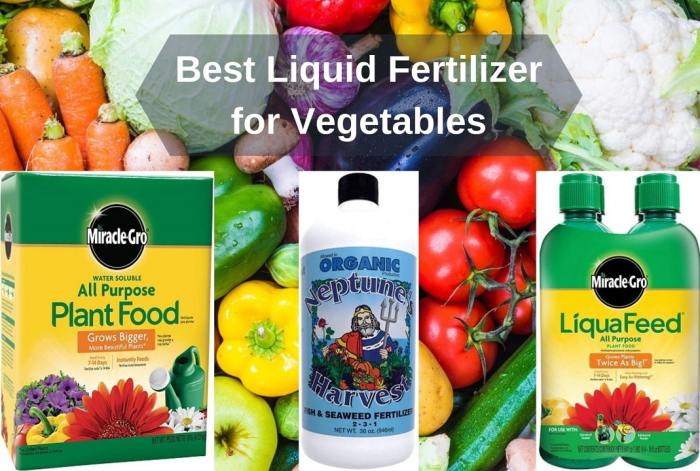
Knowing when, how, and how much fertilizer to apply is crucial for a thriving vegetable garden. Over-fertilizing can harm plants, while under-fertilizing can stunt growth. This section provides practical guidance on applying fertilizer effectively, ensuring your plants get the nutrients they need without any negative consequences.
Choosing the right fertilizer for your vegetable garden is like knowing how to season a grill – both are about getting the foundation right for delicious results. Just as you’d carefully apply oil and heat to your grill before cooking, you need to nourish your soil with the proper nutrients to help your veggies thrive.
A well-balanced fertilizer, like a blend of nitrogen, phosphorus, and potassium, can make all the difference in ensuring your garden produces an abundance of flavorful vegetables. Check out how to season a grill for a similar approach to maximizing flavor, and you’ll be on your way to a bountiful harvest.
Timing Fertilizer Application, Best fertilizers for a vegetable garden
The best time to apply fertilizer is in the early spring before planting or as a side-dressing during the growing season. Applying fertilizer before planting allows the nutrients to be incorporated into the soil, becoming available to the roots as the plants grow.
Side-dressing, which involves applying fertilizer along the rows of plants, provides additional nutrients during the active growth period.
Determining the Amount of Fertilizer to Apply
The amount of fertilizer needed varies depending on the type of vegetable, soil type, and the current nutrient levels in the soil. A soil test can provide valuable information about your soil’s nutrient composition and guide you in determining the appropriate amount of fertilizer to apply.
Soil testing kits are readily available at garden centers and online.
- Following Package Instructions:Always follow the instructions on the fertilizer package. The manufacturer provides specific recommendations for application rates based on the type of fertilizer and plant needs.
- Adjusting for Soil Type:Sandy soils tend to drain quickly, requiring more frequent fertilizer applications than clay soils, which retain nutrients better. For example, a vegetable garden with sandy soil might require a fertilizer application every 4-6 weeks, while a clay soil garden might only need fertilization every 8-10 weeks.
- Observing Plant Growth:Healthy plant growth is a good indicator of adequate nutrient levels. If you notice signs of nutrient deficiency, such as stunted growth, yellowing leaves, or poor fruit production, you may need to adjust your fertilization strategy.
Fertilizer Application Techniques
Several techniques can be used to apply fertilizer to your vegetable garden.
- Granular Fertilizer:Granular fertilizers are commonly used and easy to apply. Simply sprinkle the granules around the base of the plants, ensuring they are not in direct contact with the stems or leaves. Water the area thoroughly after application to help the nutrients dissolve and penetrate the soil.
- Liquid Fertilizer:Liquid fertilizers are available in concentrated forms that need to be diluted with water before application. They can be applied using a watering can or a hose-end sprayer. Liquid fertilizers are absorbed quickly by plants and can be used as a foliar spray, applying the solution directly to the leaves.
- Side-Dressing:Side-dressing involves applying fertilizer along the rows of plants, typically a few inches away from the base. This method provides additional nutrients during the growing season, especially for plants that require a steady supply of nutrients, such as tomatoes and cucumbers.
Slow-Release Fertilizers
Slow-release fertilizers are designed to release nutrients gradually over an extended period, typically 3-6 months. This controlled release prevents nutrient leaching and ensures a steady supply of nutrients to the plants. Slow-release fertilizers are particularly beneficial for vegetable gardens as they reduce the need for frequent fertilization.
Slow-release fertilizers are often formulated with coatings that gradually break down over time, releasing nutrients at a controlled rate.
Choosing the right fertilizer can make a huge difference in the health and yield of your vegetable garden. A balanced blend with a good ratio of nitrogen, phosphorus, and potassium will help your plants thrive, but you also need to know when to harvest your crops for optimal flavor and texture.
For example, when to harvest snap peas is crucial to ensure they are sweet and tender. Once you’ve harvested your peas, you can replenish the soil with a good dose of fertilizer to prepare for the next planting season.
Compost: A Natural Soil Amendment
Compost is a valuable soil amendment that improves soil structure, fertility, and water retention. It is rich in organic matter and essential nutrients, making it an excellent alternative to chemical fertilizers.
- Improving Soil Structure:Compost adds organic matter to the soil, improving its structure by increasing aeration and drainage. This creates a healthier environment for roots to grow and thrive.
- Enhancing Soil Fertility:Compost provides a steady supply of nutrients to plants, improving soil fertility. It contains a balanced mix of nitrogen, phosphorus, and potassium, along with other essential micronutrients.
- Increasing Water Retention:Compost helps the soil retain moisture, reducing the need for frequent watering. This is especially beneficial during dry periods.
Applying Compost
Compost can be applied to vegetable gardens in several ways:
- Topdressing:Spread a layer of compost over the soil surface, working it into the top few inches. This is an excellent way to improve soil fertility and add organic matter.
- Incorporating into the Soil:Mix compost into the soil before planting. This is particularly beneficial for new gardens or areas with poor soil quality.
- Side-Dressing:Apply compost along the rows of plants as a side-dressing, similar to granular fertilizer. This provides additional nutrients and improves soil health throughout the growing season.
Choosing the Best Fertilizer for Your Vegetables
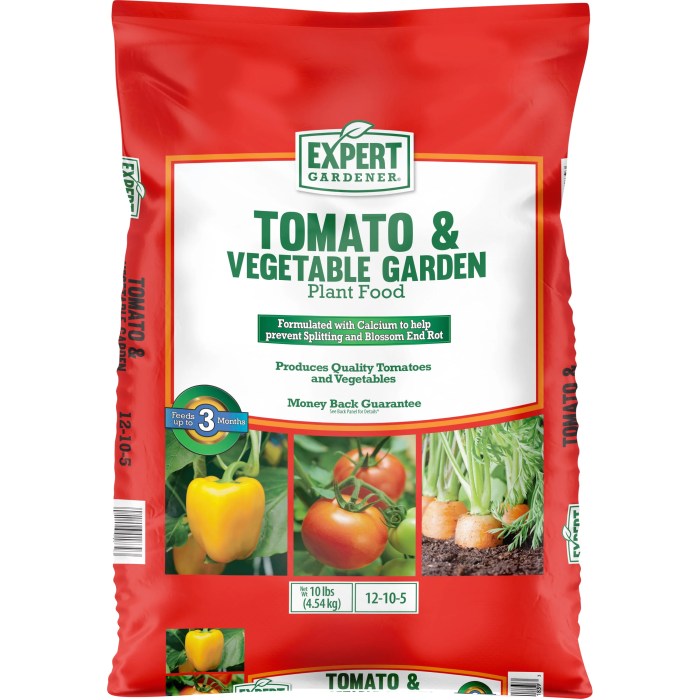
Now that you understand the basics of soil nutrients and fertilizer types, it’s time to get specific and choose the best fertilizer for your individual vegetable garden. Different vegetables have different nutrient needs, and understanding these needs will help you select the right fertilizer to ensure healthy growth and bountiful harvests.
Fertilizers for Specific Vegetable Types
Choosing the right fertilizer can make a significant difference in the growth and yield of your vegetables. Different types of vegetables have varying nutrient requirements, so it’s important to select a fertilizer that meets those needs. Here’s a breakdown of some common vegetable types and their recommended fertilizer types:
- Leafy Greens:Leafy greens like lettuce, spinach, and kale require high levels of nitrogen for vigorous leaf growth. A balanced fertilizer with a higher nitrogen content (e.g., 10-10-10) is a good choice. Organic options like compost tea or fish emulsion can also be beneficial.
- Tomatoes:Tomatoes are heavy feeders and require a balanced fertilizer with a higher phosphorus content for strong root development and fruit production. A 5-10-5 or 10-10-10 fertilizer is a good starting point. You can also use a fertilizer specifically formulated for tomatoes, which often includes additional micronutrients.
- Root Vegetables:Root vegetables like carrots, beets, and potatoes require ample phosphorus for root growth and development. A fertilizer with a higher phosphorus content (e.g., 5-10-5) is recommended. Organic options like bone meal or compost can also provide beneficial phosphorus.
- Fruiting Vegetables:Fruiting vegetables like cucumbers, peppers, and squash require a balanced fertilizer with a moderate amount of nitrogen and phosphorus for both vegetative growth and fruit production. A 10-10-10 or 12-12-12 fertilizer is suitable.
Tailoring Fertilizer Choices to Growing Conditions
The best fertilizer for your vegetables will also depend on your specific growing conditions. Here are some factors to consider:
- Climate:In hot climates, vegetables may require more frequent fertilization due to increased nutrient depletion. In cooler climates, you can fertilize less frequently.
- Soil Type:Sandy soils tend to drain quickly and may require more frequent fertilization than clay soils, which hold nutrients better.
- Plant Stage:Young seedlings require a fertilizer with a higher nitrogen content to promote leaf growth. As plants mature and begin to flower and fruit, you may need to switch to a fertilizer with a higher phosphorus content to support fruit production.
Table of Recommended Fertilizers for Vegetables
| Vegetable Type | Recommended Fertilizer |
|---|---|
| Leafy Greens | 10-10-10, Compost Tea, Fish Emulsion |
| Tomatoes | 5-10-5, 10-10-10, Tomato-Specific Fertilizer |
| Root Vegetables | 5-10-5, Bone Meal, Compost |
| Fruiting Vegetables | 10-10-10, 12-12-12 |
Sustainable Fertilizing Practices: Best Fertilizers For A Vegetable Garden
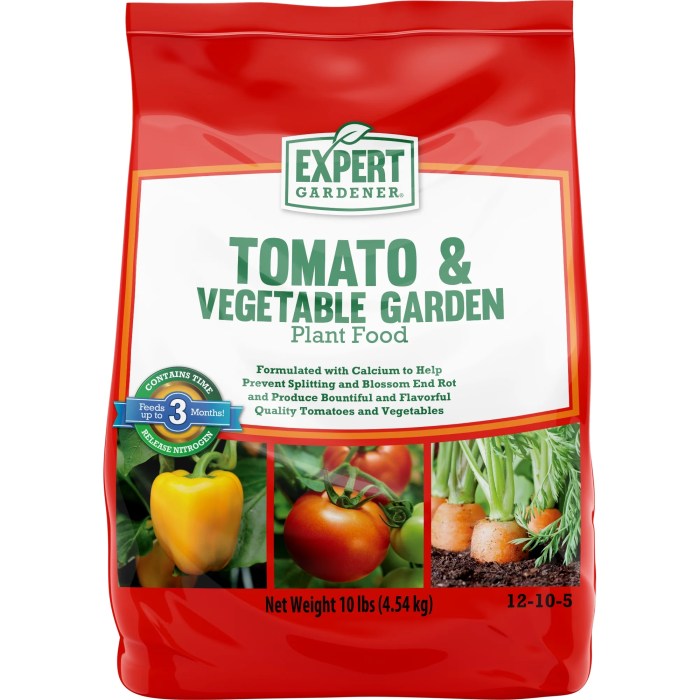
Fertilizing your vegetable garden is crucial for healthy plant growth, but it’s important to do so sustainably. Sustainable practices not only benefit your plants but also protect the environment and ensure long-term soil health.
Benefits of Natural and Organic Fertilizers
Natural and organic fertilizers are derived from plant and animal matter, providing essential nutrients to your plants without harming the environment. They are a sustainable alternative to synthetic fertilizers and offer numerous benefits.
- Improved Soil Structure:Organic matter, like compost, improves soil structure by increasing water retention, aeration, and drainage. This creates a healthier environment for roots to thrive.
- Increased Microbial Activity:Organic fertilizers encourage the growth of beneficial microbes in the soil. These microbes break down organic matter, releasing nutrients that plants can easily absorb, and improve soil fertility.
- Reduced Risk of Nutrient Leaching:Unlike synthetic fertilizers, organic fertilizers release nutrients gradually, reducing the risk of nutrient leaching into waterways and polluting water sources.
- Enhanced Nutrient Availability:Organic matter acts as a natural nutrient reservoir, making nutrients more readily available to plants over time. This reduces the need for frequent applications.
Reducing Fertilizer Runoff
Fertilizer runoff occurs when excess fertilizer washes off the soil and enters waterways. This can lead to excessive algae growth, deplete oxygen levels, and harm aquatic life.
- Apply Fertilizer Strategically:Use fertilizer only when needed and apply it directly to the root zone of plants to minimize runoff. Avoid over-fertilizing.
- Use Slow-Release Fertilizers:Slow-release fertilizers release nutrients gradually, reducing the risk of excess nutrients accumulating in the soil and potentially leaching into waterways.
- Create Buffer Zones:Plant vegetation around your garden to act as a buffer zone, slowing down water runoff and filtering out excess nutrients.
- Test Your Soil Regularly:Regular soil testing helps determine the nutrient levels in your soil and allows you to apply only the necessary amount of fertilizer, minimizing waste and runoff.
Composting Food Scraps and Yard Waste
Composting is a fantastic way to create a natural fertilizer source while reducing waste.
- Gather Compostable Materials:Collect food scraps (fruits, vegetables, coffee grounds), yard waste (leaves, grass clippings), and other organic materials.
- Choose a Composting Method:There are various composting methods, including bin composting, tumblers, and worm composting. Choose the method that best suits your needs and space.
- Maintain Proper Moisture and Aeration:Ensure the compost pile receives adequate moisture and aeration for optimal decomposition. Turning the compost regularly helps with aeration.
- Wait for Decomposition:It takes several weeks to months for compost to decompose fully. Once the compost is dark, crumbly, and earthy-smelling, it’s ready to use.
Concluding Remarks

By understanding the principles of soil health and the various fertilizer options available, you can create a thriving vegetable garden that produces delicious and nutritious food. Remember, choosing the right fertilizer and applying it effectively are crucial steps in achieving your gardening goals.
With a little knowledge and careful planning, you can enjoy the satisfaction of growing your own produce, knowing you’re contributing to a healthy ecosystem.